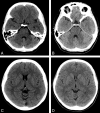Lowering the dose in head CT using adaptive statistical iterative reconstruction
- PMID: 21835946
- PMCID: PMC7965395
- DOI: 10.3174/ajnr.A2585
Lowering the dose in head CT using adaptive statistical iterative reconstruction
Abstract
Background and purpose: While CT has found wide use in medical practice, it is also a substantial source of radiation exposure and is associated with an increased lifetime risk of cancer. There is an urgent need for new approaches to reduce the radiation dose in CT. In this regard, ASIR is an alternative method to FBP. We assessed the effect of ASIR on dose reduction in adult head CT.
Materials and methods: We retrospectively evaluated a sample of 149 adult head CT examinations that were divided into 2 groups, STD and LD. We lowered the tube current and used ASIR in the LD group. SNR and CNR were analyzed. Dose parameters were recorded while subjective image noise, sharpness, diagnostic acceptability, and artifacts were graded. The Student t test, the Mann-Whitney U test, and κ statistics were used for statistical analyses.
Results: We achieved a dose reduction of 31% in the LD group (STD, 2.3 ± 0.1 mSv; LD, 1.6 ± 0.1 mSv; P < .001). There was no significant difference in the noise measured in the air between the 2 comparison groups (P = .273). Noise in the CSF was higher in the STD group (P < .001), while the noise in the WM was higher in the LD group (P < .001). Differences in the CNR between groups were insignificant, but the STD group displayed better SNR values. There was no significant difference in the modal scores of diagnostic acceptability (P = .062) and the artifacts (P = .148) between the 2 groups. Better scores for subjective image noise (P < .001) and sharpness (P = .04) were observed in the STD group.
Conclusions: ASIR appears to be useful in reducing the dose in adult head CT examinations. While the effect of ASIR on noise reduction observed in the present study of head CT is less than that reported previously in abdomen and chest CT, these findings encourage further prospective studies in larger patient samples.
Figures


References
-
- Hall EJ, Brenner DJ. Cancer risks from diagnostic radiology. Br J Radiol 2008; 81: 362–78 - PubMed
-
- Brenner DJ, Hall EJ. Computed tomography: an increasing source of radiation exposure. N Engl J Med 2007; 357: 2277–84 - PubMed
-
- Gunn MLD, Kohr JR. State of the art: technologies for computed tomography dose reduction. Emerg Radiol 2010; 17: 209–18 - PubMed
-
- Rogalla P, Kloeters C, Hein PA. CT technology overview: 64-slice and beyond. Radiol Clin North Am 2009; 47: 1–11 - PubMed
MeSH terms
LinkOut - more resources
Full Text Sources
Medical
Research Materials
Miscellaneous
